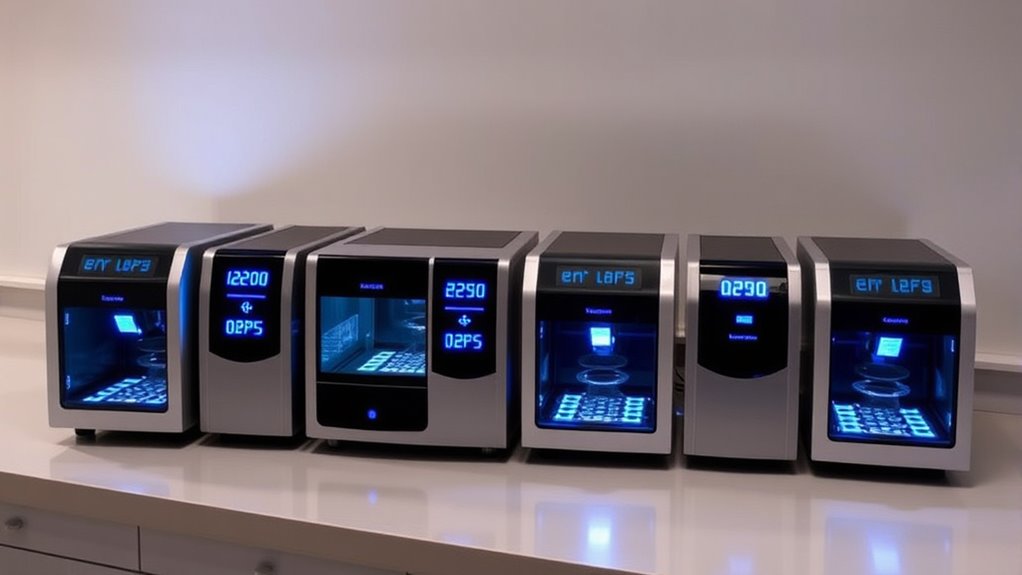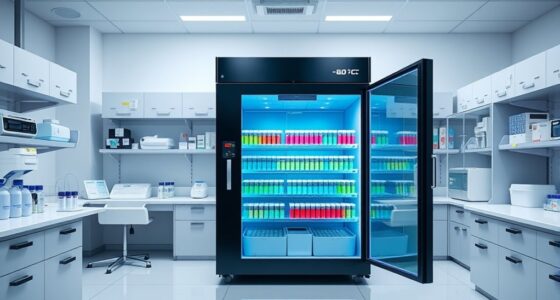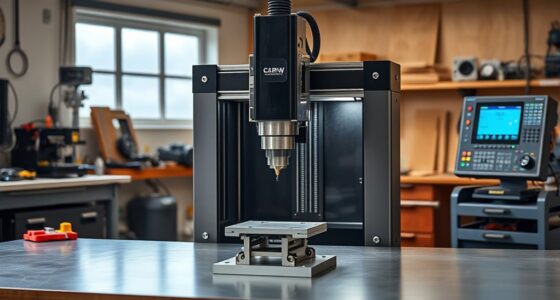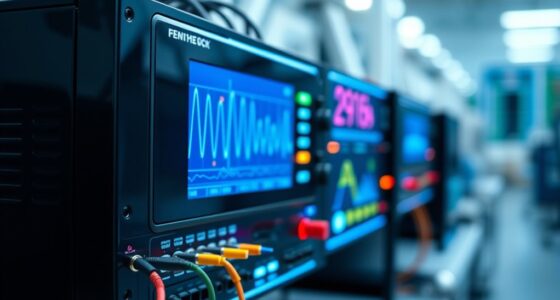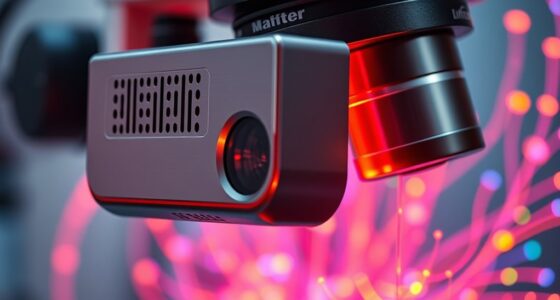If you’re looking for the best fluorescence microplate readers of 2025, I recommend considering versatile systems like the Tecan SPECTRAFluor Plus, which offers multiple detection modes and rapid measurements. Devices like the Elisa Absorbance Plate Reader or MR9600-T focus on speed, precision, and user-friendly interfaces. Factors like wavelength range, data management, and budget are key. Keep exploring these options, and you’ll find the perfect fit for your research needs.
Key Takeaways
- Devices like Tecan SPECTRAFluor Plus and Benchmark MR9610 offer high sensitivity, fast measurement speeds, and customizable optical configurations for precise fluorescence detection.
- User-friendly interfaces with touchscreen controls and software support streamline operation, reducing training time and enhancing workflow efficiency.
- Compatibility with diverse plate formats, multiple detection modes, and customizable filters ensure versatility for various assay types.
- Robust data management features—including extensive storage, easy export options, and automated calibration—support reliable, high-throughput experiments.
- Compact, durable designs with modular optical components and automated routines optimize maintenance, durability, and performance consistency.
Tecan SPECTRAFluor Plus Microplate Reader
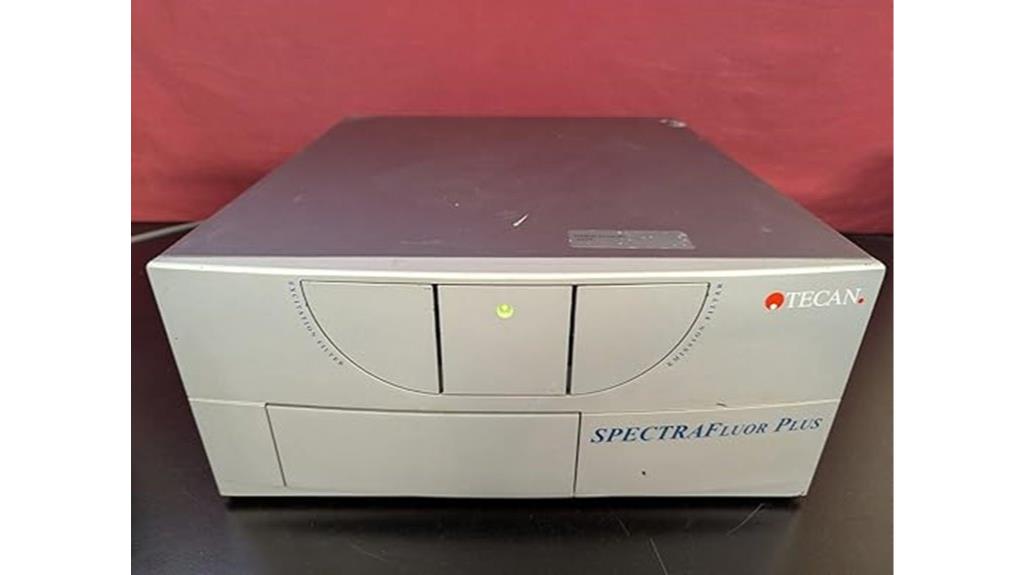
The Tecan SPECTRAFluor Plus Microplate Reader stands out for its versatile detection modes, making it an excellent choice for labs that need flexibility. I’ve used it in various applications, and its ability to switch seamlessly between fluorescence, absorbance, and luminescence measurements saves time and streamlines workflows. Its sensitivity and accuracy give me confidence in the data I collect, whether for research, diagnostics, or high-throughput screening. Plus, it’s part of Tecan’s trusted line of instrumentation, ensuring reliability. If you’re looking for a reliable, multi-mode reader that adapts to different assay types, this model is a smart investment.
Best For: researchers and laboratory professionals needing a versatile, reliable microplate reader for fluorescence, absorbance, and luminescence assays across various applications.
Pros:
- Supports multiple detection modes, reducing the need for multiple instruments
- High sensitivity and accuracy for dependable data collection
- Seamless switching between measurement types to streamline workflows
Cons:
- May require specific training for optimal use of all features
- Potentially higher cost compared to single-mode readers
- Size and setup might be less suitable for very limited laboratory space
10-inch Touch Screen Elisa Absorbance Plate Reader with 8 Channels and 10 Filters
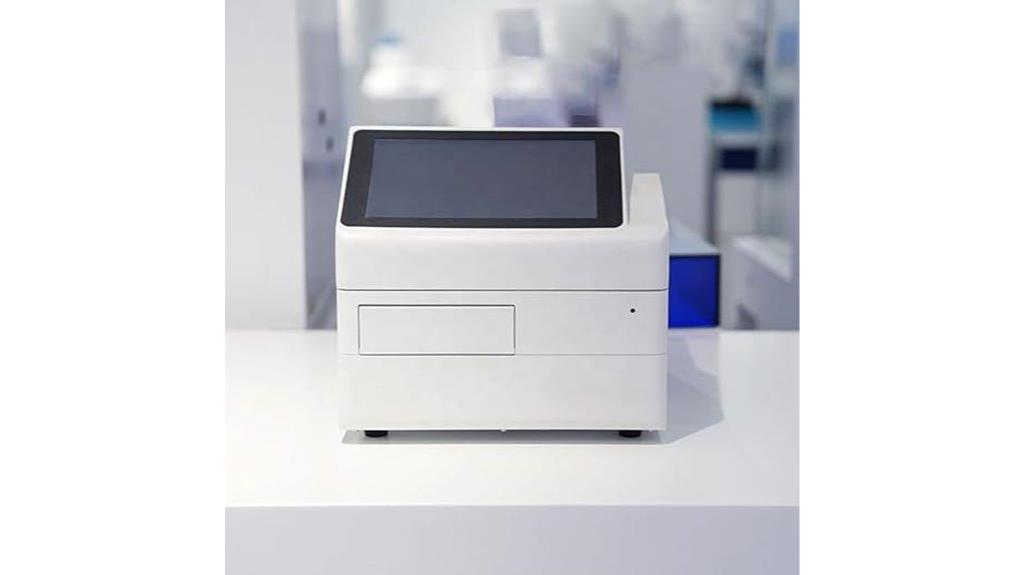
An excellent choice for labs seeking precise, user-friendly absorbance measurements, the 10-inch Touch Screen Elisa Absorbance Plate Reader with 8 Channels and 10 Filters stands out with its large, intuitive touchscreen interface. You can operate it entirely on-screen, without a computer, thanks to its responsive, easy-to-navigate display. It offers rapid readings in just 7 seconds across eight channels, with high accuracy and stability comparable to high-end spectrophotometers. The device supports multiple standard wavelengths and customizable filters, making it versatile for various assays. Its compact design, combined with reliable performance and excellent user support, makes it an ideal choice for modern, efficient laboratories.
Best For: research laboratories and institutions seeking precise, user-friendly, high-throughput absorbance measurement solutions with minimal setup.
Pros:
- Large, intuitive 10-inch touchscreen allows for complete on-screen operation without a computer.
- Rapid absorbance measurements in just 7 seconds across 8 channels, ensuring high efficiency.
- High accuracy and stability comparable to expensive spectrophotometers, suitable for a variety of assays.
Cons:
- The device may require additional filters for specialized assays, which could involve extra cost and ordering time.
- Its size and weight (13kg) may necessitate dedicated space and careful handling.
- Some users might need initial training to fully utilize advanced software features and custom wavelength settings.
Elisa Microplate Reader with 8 Channels
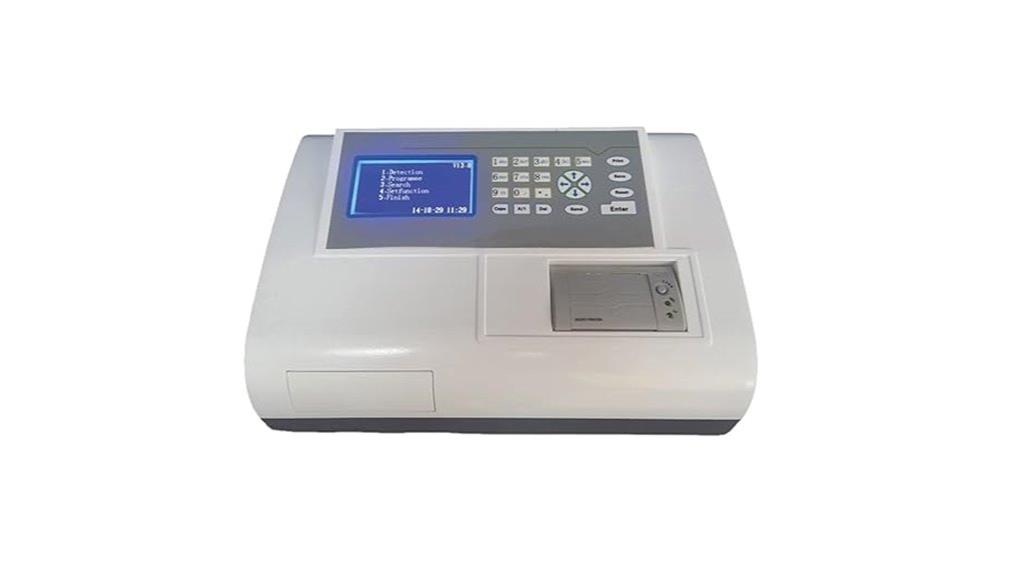
For laboratories seeking rapid, accurate fluorescence detection across multiple assays, the Elisa Microplate Reader with 8 channels stands out. It features an 8-channel optical system covering 400nm to 800nm, making it versatile for various assay types. Compatible with 48-well and 96-well plates, it adapts to different experimental formats. The device includes automatic filter selection, self-checking, and error display on the LCD, simplifying operation. Supporting single and dual wave detection, it can store results from up to 100 plates. Its high sensitivity, speed, and user-friendly design boost efficiency and guarantee reliable, precise measurements every time.
Best For: laboratories requiring rapid, accurate fluorescence detection across multiple assay formats with user-friendly operation and high data capacity.
Pros:
- Versatile 8-channel optical system covering 400nm to 800nm wavelengths for diverse assays
- Compatible with both 48-well and 96-well plates, supporting various experimental needs
- Automated features like filter selection, self-checking, and error display streamline operation and reduce user errors
Cons:
- Limited to fluorescence detection within specified wavelength range, not suitable for other assay types
- May require training for optimal use of automatic modes and data management features
- Dependence on electronic components means potential downtime if technical issues arise
MR9600-T SmartReader 96 Microplate Absorbance Reader
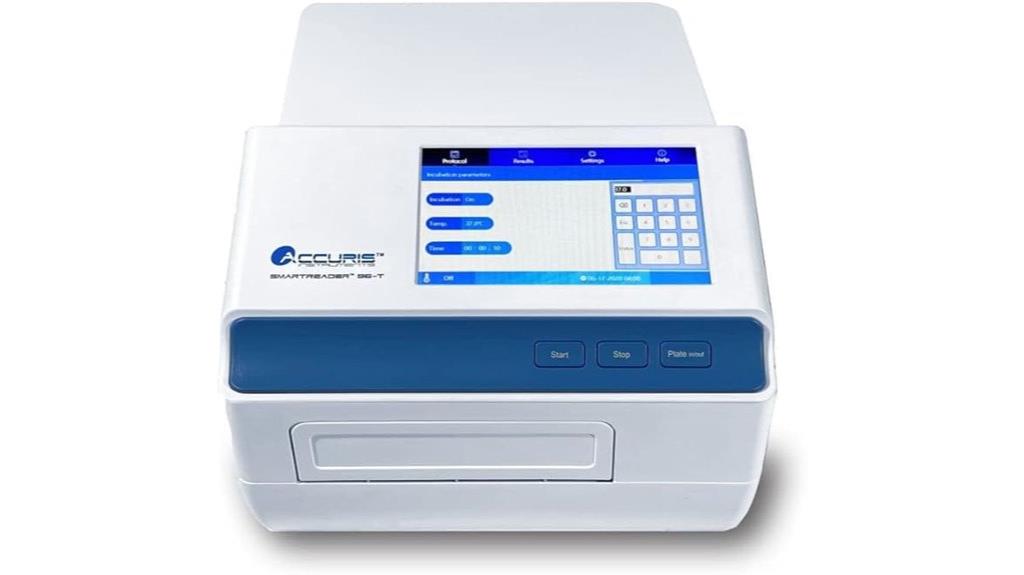
If you’re seeking a reliable and user-friendly microplate absorbance reader for routine ELISA and concentration measurements, the MR9600-T SmartReader 96 stands out. It features a 7-inch color touchscreen with intuitive software, allowing standalone operation without a computer. Its filter-based system covers wavelengths from 340 to 750 nm, and the 8-channel vertical optical path ensures accurate absorbance readings up to 4.0000 Abs. The integrated multi-speed shaker guarantees thorough mixing, and with four standard filters plus twenty-six additional options, it’s versatile. Overall, this device offers precise, efficient measurements ideal for busy laboratories performing routine ELISA and concentration assays.
Best For: laboratories conducting routine ELISA, concentration, and absorbance measurements requiring a reliable, user-friendly microplate reader with versatile filter options and standalone operation.
Pros:
- Intuitive 7-inch color touchscreen with graphical interface for easy operation
- Wide wavelength range (340-750 nm) with multiple filter options for versatility
- Integrated multi-speed shaker ensures thorough mixing and consistent results
Cons:
- Limited to absorbance measurements within the specified wavelength range, not suitable for fluorescence or other detection modes
- Absence of built-in computer may require external data transfer devices for advanced data analysis
- May be less suitable for highly specialized or research-driven applications requiring advanced optical configurations
Benchmark Accuris SmartReader UV-Vis MR9610 Microplate Reader
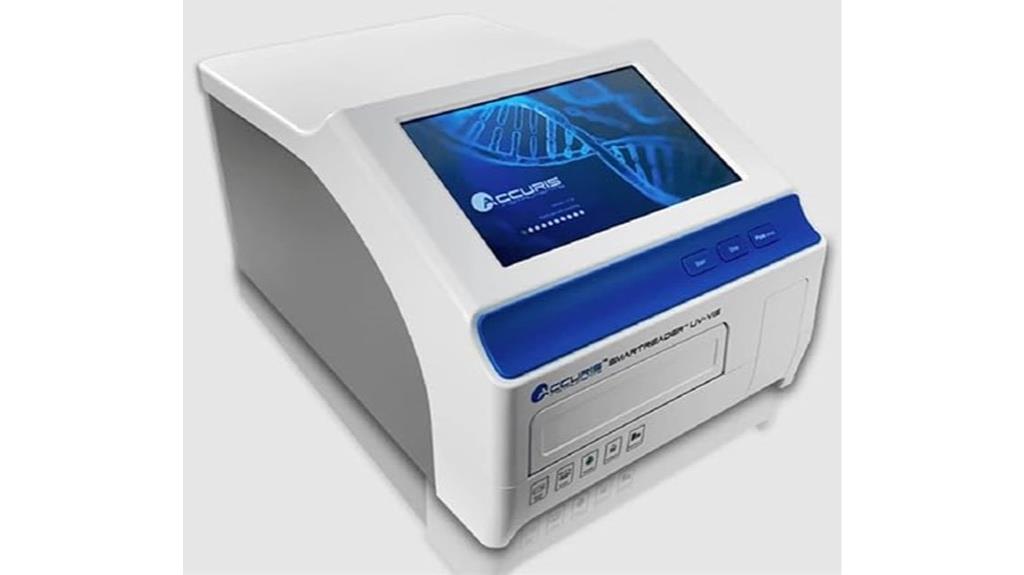
The Benchmark Accuris SmartReader UV-Vis MR9610 stands out for its user-friendly design, making it ideal for busy laboratories with multiple users who need quick and reliable results. Its 10-inch color touch screen and optional mouse control simplify operation, while the USB ports enable easy data transfer without needing a PC or specialized software. Capable of reading 96- and 384-well plates within seconds, it offers precise wavelength selection and high accuracy, thanks to its monochromator and dual detectors. Its compact size, stable performance, and robust storage capacity make it a versatile choice for high-throughput environments demanding accuracy and efficiency.
Best For: busy laboratories and high-throughput research settings seeking fast, reliable UV-Vis spectrophotometry without the need for complex software.
Pros:
- User-friendly 10-inch touch screen and optional mouse control for easy operation
- Rapid measurement times (<6 seconds for 96-well plates) suitable for high-volume testing
- No PC or special software required, with versatile USB data transfer and large storage capacity
Cons:
- Limited to UV-Vis wavelength range (200-1000 nm), not suitable for other spectral analyses
- Relies on monochromator for wavelength selection, which may require calibration and maintenance
- The device’s size and weight may be less portable for field applications
Elisa Micro Plate Assay with Customize Filter
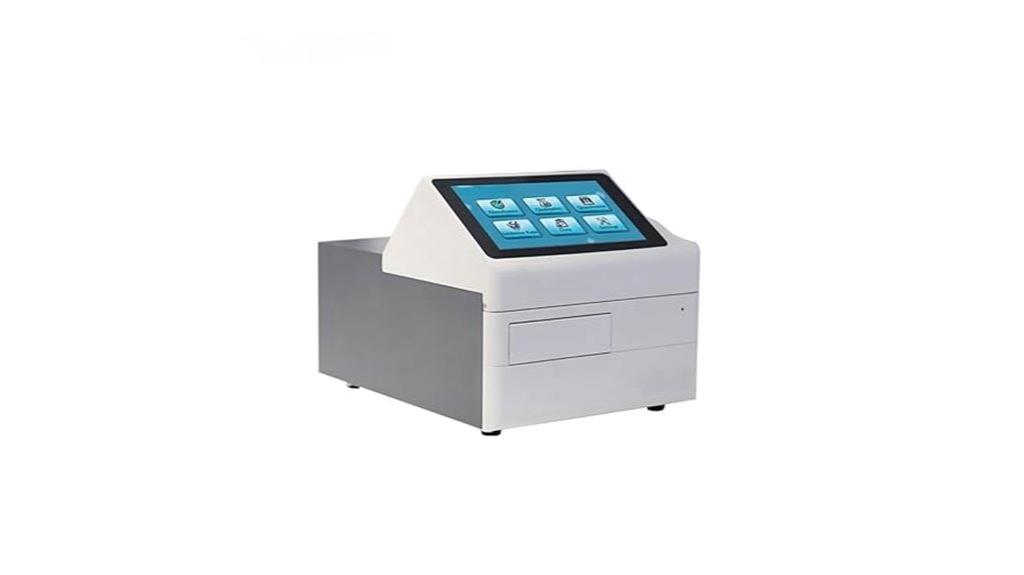
Looking to customize your fluorescence measurements with precision? The Elisa Micro Plate Assay with Customize Filter offers rapid 7-second readings via an 8-channel vertical optical system. Its large 10-inch touch screen provides an intuitive interface, allowing easy setup and filter adjustments. With hardware featuring high-performance ARM architecture and ADI high-precision AD conversion, it guarantees stable, accurate results. Standard filters cover key wavelengths, and up to six additional filters (200-800nm) can be installed for tailored assays. Its excellent linear range, low CV, and high stability make it ideal for precise, flexible fluorescence measurements in various laboratory settings.
Best For: researchers and laboratories seeking rapid, customizable fluorescence measurements with high accuracy and stability for diverse assay applications.
Pros:
- Rapid 7-second measurement speed with an 8-channel vertical optical system for high throughput.
- Customizable filters (up to 6 additional filters 200-800nm) for tailored fluorescence assays.
- User-friendly large touch screen interface with stable, precise hardware components ensuring reliable results.
Cons:
- As an imported product, it may require detailed customs clearance procedures and customer contact info.
- Limited to laboratory environments with space for device dimensions of 535mm x 395mm x 395mm.
- Custom filter options require prior contact with the seller, which may extend setup time.
Biotek ELx808 Microplate Reader
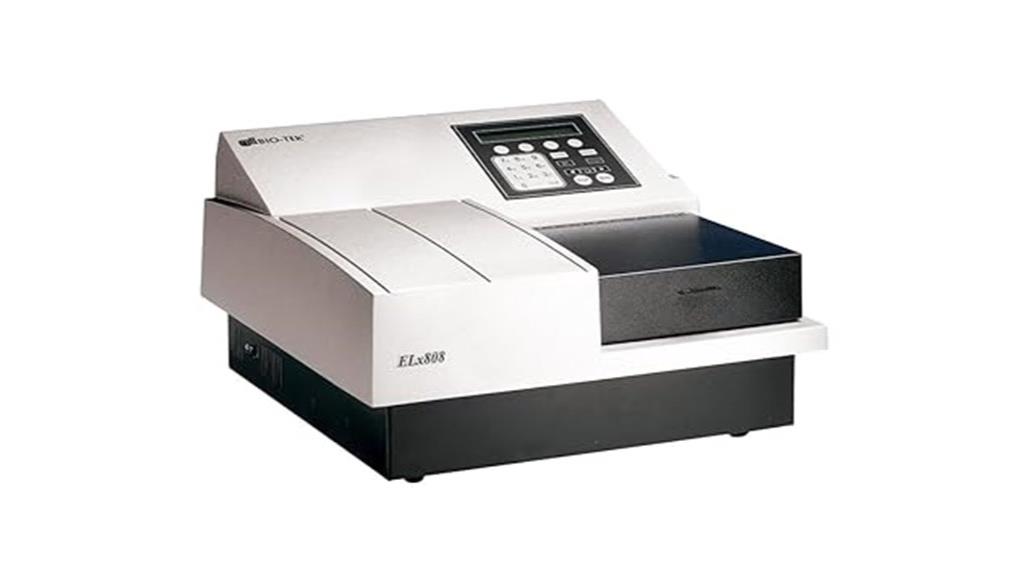
Designed for laboratories requiring precise, reliable absorbance measurements, the Biotek ELx808 Microplate Reader stands out with its rapid 8-second reading speed and user-friendly software. It supports applications like ELISA, protein, and nucleic acid quantification, making it versatile for biotech and clinical labs. With a wavelength range of 380-900nm and a 96-well capacity, it handles various assay types, including end point, kinetic, and linear scans. The onboard control features a simple LCD, while Gen5 software offers 55 programmable protocols. Certified CE and TÜV compliant, it guarantees quality and safety, making it a dependable choice for precise absorbance measurements.
Best For: research laboratories and clinical labs seeking rapid, accurate absorbance measurements for applications like ELISA, protein, and nucleic acid quantification.
Pros:
- Fast 8-second reading speed enhances workflow efficiency
- User-friendly Gen5 software with 55 customizable protocols simplifies operation
- Wide wavelength range (380-900nm) suitable for various assays and applications
Cons:
- Limited to 96-well microplates, which may restrict high-throughput needs
- Optional data analysis software sold separately, adding to overall cost
- Requires connection to a computer and printer, which may limit portability
Biotek ELx800 Absorbance Microplate Reader
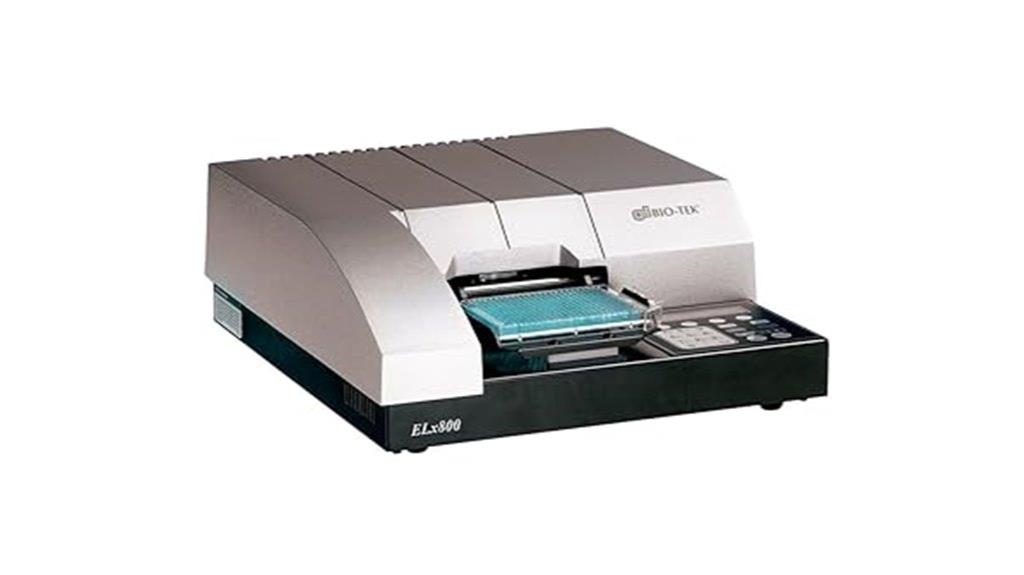
If you’re searching for a reliable absorbance microplate reader that meets high standards of quality and versatility, the Biotek ELx800 stands out as a top choice. It’s ideal for clinical, biotech, and pharma labs, handling ELISA, protein, and nucleic acid assays with ease. With a wavelength range of 400-750nm and a dynamic OD range of 0-3, it delivers precise measurements with 0.001 OD resolution. Supporting 6- to 96-well plates and equipped with five filters, it’s fast—about 30 seconds for a full 96-well read. Its user-friendly software offers customizable protocols, making it a dependable, efficient tool for your research needs.
Best For: researchers and laboratory professionals in clinical, biotechnological, and pharmaceutical settings seeking reliable, versatile absorbance measurement for ELISA, protein, and nucleic acid assays.
Pros:
- Supports a wide wavelength range (400-750nm) with high precision (0.001 OD resolution).
- Rapid reading times (~30 seconds for 96 wells), enhancing workflow efficiency.
- User-friendly interface with customizable protocols and comprehensive software support.
Cons:
- Limited to 6- to 96-well microplates, not compatible with other plate formats.
- Only includes four pre-selected filters, which may limit flexibility for certain assays.
- Relies on external computers and printers for full data management, requiring additional setup.
Factors to Consider When Choosing Fluorescence Microplate Readers
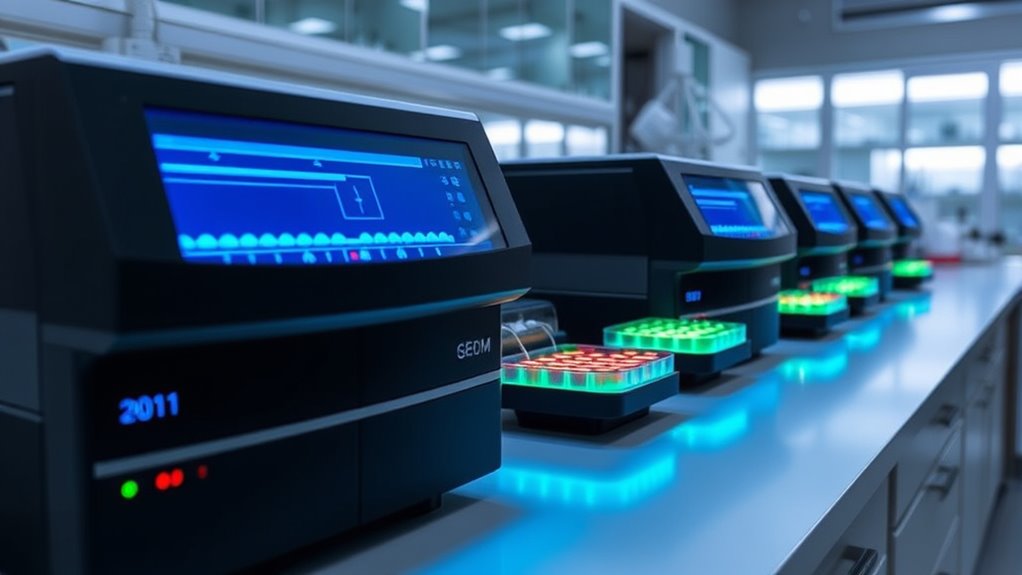
When selecting a fluorescence microplate reader, I focus on the detection mode options to guarantee it meets my assay needs. I also consider the wavelength range, sensitivity, and software interface to streamline my workflow. Finally, compatibility with various assays is vital for versatility and accurate results.
Detection Mode Versatility
To effectively support a wide range of assays, a fluorescence microplate reader must offer versatile detection modes. Supporting endpoint, kinetic, and time-resolved fluorescence allows me to handle diverse experimental designs efficiently. A broad selection of excitation and emission filters or monochromators enables detection across different wavelengths, accommodating various fluorescent labels. The ability to perform dual or multiple channel measurements simultaneously boosts throughput and facilitates multiplexed assays. Compatibility with advanced techniques like fluorescence polarization, FRET, or TRF expands the platform’s capabilities for complex analyses. Flexibility in adding or customizing filters and detection modes ensures I can tailor the device to specific research needs and stay adaptable as new fluorescence assays emerge. Flexibility in detection modes is key to maximizing both performance and application scope.
Wavelength Range Options
Choosing the right wavelength range is essential for maximizing the versatility and sensitivity of a fluorescence microplate reader. Most models cover approximately 300 to 700 nm, accommodating a broad array of dyes like FITC, Cy3, and Rhodamine, each with unique excitation and emission peaks. Several readers support multiple excitation and emission wavelengths, often with customizable filters or monochromators, making them adaptable to various assays. For specialized applications, some advanced models include UV capabilities around 200-400 nm, enabling detection of UV-excited fluorophores or intrinsic fluorescence. The selected wavelength range influences detection sensitivity and specificity, guaranteeing you can accurately measure fluorescence signals across different experimental setups. Carefully matching the wavelength options to your assay requirements assures optimal performance and reliable results.
Sensitivity and Precision
Selecting a fluorescence microplate reader with high sensitivity and precision guarantees you get reliable, reproducible results across various assays. High sensitivity lets you detect low-abundance analytes with a signal-to-noise ratio over 10:1, ensuring even faint signals are measurable. Precision is essential for consistency; parameters like a repeatability CV of ≤1.0% and stability within ±0.003 Abs keep measurements consistent over multiple runs. Accurate wavelength calibration within ±2 nm and repeatability within ±1.5 nm are imperative for precise excitation and emission data. Additionally, a linear dynamic range covering at least four orders of magnitude allows accurate quantification of both high and low fluorescence signals. Regular calibration and quality control are necessary to maintain these standards, preventing drift and ensuring your data remains dependable over time.
Software User Interface
A user-friendly software interface is essential for efficient operation of fluorescence microplate readers. An intuitive layout simplifies tasks, reducing training time and minimizing errors. Touchscreen controls with visual menus and easy parameter adjustments make complex assays straightforward, even for new users. Compatibility with gloves or stylus ensures smooth operation in sterile or constrained environments. Software that offers customizable protocols and algorithms provides flexibility, accommodating diverse experimental needs. Reliable data management features, like sample saving, standard curve generation, and export options, streamline workflow and data analysis. Overall, a well-designed interface enhances productivity, minimizes frustrations, and guarantees accurate results. When choosing a fluorescence microplate reader, prioritize software that combines ease of use with powerful functionality to support your research effectively.
Compatibility With Assays
When evaluating fluorescence microplate readers, it’s vital to confirm they support the specific excitation and emission wavelengths required by your assays, such as 405nm or 488nm. Verify the device can handle your plate formats, whether 96-well, 384-well, or custom plates. It’s also important that the reader offers multiple detection modes like fluorescence intensity, time-resolved fluorescence, or FRET, to match your assay needs. Compatibility with your reagents and labels, such as fluorescent dyes or proteins, ensures accurate, sensitive measurements. Additionally, check if the instrument allows for customizable filter sets or monochromator adjustments, so you can adapt to evolving protocols. Ensuring compatibility helps streamline your workflow and guarantees reliable, reproducible results.
Data Storage Capacity
Adequate data storage capacity is essential to guarantee your fluorescence microplate reader can handle large datasets, especially during high-throughput screening or multi-plate experiments. You should look for devices that support storing results from at least 100 plates or more, ensuring efficient data management. Check if the system allows easy exporting or backing up via USB, network, or cloud options to prevent data loss and enable further analysis. Internal organization features like file naming, categorization, or automatic sorting can streamline your workflow. Additionally, verify that the software permits quick data retrieval, search functions, and compatibility with analysis programs. Having ample and flexible storage options ensures seamless data handling, minimizes disruptions, and maximizes your productivity during intensive experimental sessions.
Ease of Maintenance
Choosing a fluorescence microplate reader that’s easy to maintain can save you time and reduce frustration during your experiments. I look for models with modular optical components, so I can replace or service parts without disassembling the entire device. Self-calibration and automated routines are also game-changers, minimizing manual adjustments and cutting downtime. Easy access to optical paths and straightforward cleaning procedures help keep the instrument running smoothly and extend its lifespan. I also prioritize clear user manuals and troubleshooting guides, which simplify routine upkeep and reduce reliance on technical support. Compatibility with readily available spare parts and consumables ensures quick repairs and consistent performance over time. These features make maintenance less of a chore and more of a seamless part of daily laboratory operations.
Cost and Budget
The cost of a fluorescence microplate reader can vary markedly, from a few thousand dollars for basic models to over $50,000 for advanced systems. When budgeting, I consider not just the initial purchase price but also ongoing expenses like maintenance, replacement parts, and software updates. Cheaper models might have limited detection modes or wavelength ranges, which could restrict their suitability for specific assays. To make a cost-effective choice, I evaluate whether the device’s performance meets my required precision and sensitivity standards. Comparing the total cost of ownership, including consumables and technical support, helps guarantee the system aligns with my financial resources. Balancing features and budget is vital to selecting a reader that delivers reliable results without overspending.
Frequently Asked Questions
How Do Fluorescence Microplate Readers Differ From Absorbance Readers?
Fluorescence microplate readers detect signals emitted by fluorescent substances, which means I use them when I need high sensitivity and specific detection of target molecules. Absorbance readers, on the other hand, measure how much light is absorbed by a sample, making them ideal for straightforward assays like protein concentration. I choose fluorescence readers for detailed, sensitive measurements, while absorbance readers suit simpler, broad-spectrum analyses.
What Is the Ideal Throughput for High-Volume Laboratory Settings?
Think of throughput like a busy highway—more lanes, faster traffic flow. For high-volume labs, an ideal throughput means processing hundreds to thousands of samples daily without bottlenecks. I recommend choosing a fluorescence microplate reader that offers rapid plate reading capabilities, automation options, and minimal downtime. This way, your lab can keep up with demand, ensuring accurate results while maintaining efficiency and productivity across all your projects.
How Important Is Filter Customization for Specific Assays?
Filter customization is vital for specific assays because it guarantees ideal signal detection and reduces background noise. I always prioritize microplate readers that allow flexible filter adjustments, especially when working with diverse fluorescent dyes. Customizable filters help me fine-tune measurements, improve accuracy, and adapt to new assay requirements quickly. Without this feature, I’d struggle to achieve the precision and reliability needed for high-quality results.
Can These Readers Be Integrated With Laboratory Automation Systems?
Absolutely, these readers can often be integrated with laboratory automation systems. I’ve found that many modern fluorescence microplate readers offer compatibility with automation platforms, streamlining workflows and reducing manual errors. It’s essential to check the specific model’s connectivity options, like Ethernet or USB ports, and software compatibility. This integration boosts efficiency, especially for high-throughput labs, making data collection and analysis faster and more reliable.
What Maintenance and Calibration Procedures Are Recommended for Longevity?
To guarantee longevity, I recommend regular cleaning of the optical components and calibration according to the manufacturer’s schedule. I also perform routine checks on the lamp, filters, and detectors, replacing parts as needed. Keeping detailed maintenance logs helps me track performance and plan preventive actions. Proper storage and avoiding exposure to dust or moisture further extend the life of my fluorescence microplate reader, maintaining its accuracy over time.
Conclusion
Choosing the right fluorescence microplate reader is like selecting the perfect compass for a scientific voyage—guiding you through the vast ocean of data with precision and confidence. Each of these top picks shines like a lighthouse in the fog, illuminating your path to accurate results. By considering your specific needs, you’ll find a device that not only performs but elevates your research, turning complex data into a symphony of discovery.
